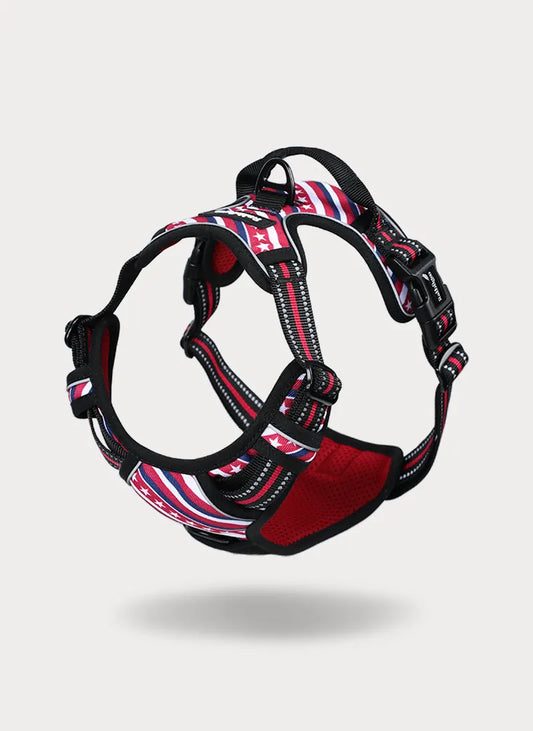What Colors Can Dogs See: Understanding Dog Vision
If you've ever taken your dog to a store to pick out their favorite toy, water bowl, or harness, you might have noticed they seem to gravitate towards blue or yellow. This instinctive attraction could be linked to how dogs perceive colors differently from humans. Knowing what colors dogs can see is not only interesting but also valuable for many dog owners. It can help you select accessories that not only look great but also enhance your pet's experience and enjoyment.
What's the Difference Between Dog and Human Vision?
Humans see the world one way, while dogs see it quite differently. Humans have trichromatic vision, meaning we can perceive a broad range of colors due to three types of cone cells in our eyes: red, green, and blue. This allows us to experience a rich spectrum of hues, from vibrant reds to lush greens and cool blues. In contrast, dogs are dichromats, meaning they only have two types of cone cells: one for blue and one for yellow. As a result, their vision is limited to a smaller color spectrum, making them effectively colorblind to red and green.
For dogs, the world isn’t as colorful as it is for us. Colors like red and green are indistinguishable to them, blending into shades of gray or brown. For example, what we perceive as a green park or a colorful garden may appear to a dog as a more muted yellowish or grayish landscape.
What Colors Can Dogs See?
From the previous explanation, you might have guessed that the colors dogs can see are mainly yellow and blue. To be more specific, dogs can see colors like black, brown, tan,yellow, gray, light blue, blue, and dark blue. Although dogs' color perception is limited, this doesn't mean they can't appreciate the beauty of the world. In fact, dogs rely more on brightness and contrast to perceive their surroundings. Therefore, even in a world with relatively dull colors, they can still find joy and comfort.
What's even more important is that dogs have an exceptionally keen sense of smell and hearing, which allows them to gather rich details and experiences through other senses. Their sense of smell and hearing provide them with an entirely different perspective, making their world far more vibrant and colorful than we might imagine.
What Does This Mean for Dog Owners?
A deeper understanding of what colors dogs can see helps pet owners make more thoughtful and confident decisions. This knowledge not only creates a better environment for your dog but also brings more joy to everyday life. With this insight into their color vision, both owners and dogs can enjoy more romantic and heartwarming moments together.
3 Practical Implications for Dog Owners
So, how can this insight help you in everyday moments with your dog? Let’s take a look!
#1 Color Choices That Help Your Dog
Changing your dog’s toy color from red to blue or yellow can help them spot and enjoy their favorite playthings more easily. If you’re not particular about color, you can also choose toys with high contrast or vivid saturation. Even within shades of gray, variations like light gray and dark gray can create enough distinction to keep things visually interesting for your dog. The key is to make their toys stand out because what’s easy to see is often the most fun to chase. A small adjustment like this can make playtime much more engaging for your pup.
The same idea applies to other products such as dog harnesses and leashes. Choosing blue, yellow, or any color with high contrast and vivid saturation can make a surprising difference. These colors are easier for dogs to recognize and may reduce the confusion or hesitation they feel toward less visible gear. When your dog can easily see their harness, they are more likely to approach it willingly and respond faster during walks and training. This small visual advantage can also make training easier by helping your dog stay more focused and engaged.
#2 Designing a Space Your Dog Will Love
Enhancing your dog’s environment isn’t just about providing food and shelter—it’s about creating a space that feels engaging and expressive. Consider using focal points, such as a bright blue bed or a yellow feeding bowl, to help guide your dog’s attention. These visual cues not only make their surroundings more inviting but also help them understand where to rest, play, or eat. Small design choices like these can make your home feel more vibrant and dog-friendly.
#3 Designing a Space Your Dog Will Love
Spending time outside with your dog on sunny days is one of the best ways to keep them happy and healthy. Fall is especially perfect for outdoor adventures, the golden leaves, crisp air, and bright blue skies create a colorful world that dogs love to explore.
Take a walk through the park, play a quick game of fetch, or simply relax together under the autumn sun. These simple moments not only keep your dog active but also deepen your connection in a calm, natural way. For many dogs, this season is the most vibrant and joyful time of the year—and sharing it with you makes it even better.
Conclusion
Understanding how your dog sees the world gives you more than just fascinating facts—it helps you see things from their perspective. By choosing colors and environments that appeal to your dog’s unique vision, you create a world that feels more comfortable, engaging, and joyful for them.
At the heart of it, every color, walk, and shared moment becomes part of a deeper connection between you and your furry companion. When you take the time to see the world through your dog’s eyes, you’ll find that life together becomes brighter, more meaningful, and filled with simple, colorful joys.





